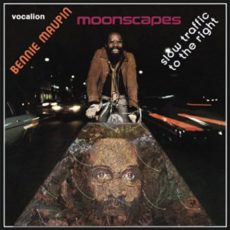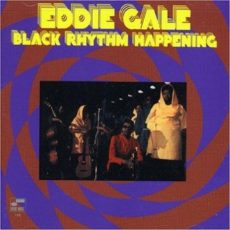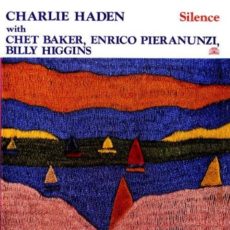
Daily Dose Of Jazz…
Bennie Maupin was born August 29, 1940 in Detroit, Michigan. He started playing tenor saxophone in high school and attended the Detroit Institute for Musical Arts, while playing locally. He moved to New York in 1963, freelancing with many groups, including ones led by Marion Brown and Pharoah Sanders.
Well known for his playing as a part of Herbie Hancock’s Mwandishi sextet and Headhunters band and for performing on Miles Davis’s seminal fusion record, Bitches Brew. Maupin has collaborated with Horace Silver, Roy Haynes, Woody Shaw, Lee Morgan and many others. He has also performed on several Meat Beat Manifesto albums.
Noted for having a harmonically-advanced, “out” improvisation style, while having a different sense of melodic direction than other “out” jazz musicians such as Eric Dolphy.
Maupin was also a member of Almanac, a group with bassist Cecil McBee, pianist Mike Nock and drummer Eddie Marshall. He has recorded a half dozen albums as a leader and another three dozen as a sideman with John Beasley, Marion Brown, Mike Clark, Miles Davis, Jack DeJohnette, Eddie Henderson, Andrew Hill, Darek Oles, Lonnie Smith, McCoy Tyner, Lenny White, Patrick Gleeson and Jim Lang.
Multireedist Bennie Maupin, who plays various saxophones, flute and bass clarinet, failed to catch on as a bandleader, thus maintained a low profile during the past 15 years, until emerging in 2006 with the critically acclaimed Penumbra followed two years later Early Reflections on the Cryptogramophone label, then on Vocalion with Slow Traffic To The Left, Moonscapes. He continues to perform and tour.
Sponsored By
![]()

Daily Dose Of Jazz…
Eddie Gale was born in Brooklyn, New York on August 15, 1941 and early in life he studied trumpet with Kenny Dorham. In the early 1960s he was introduced to Sun Ra by drummer Scoby Stroman and spent many hours exposed to Sun Ra’s philosophy about music and life. During this period he explored the use of trills, placement of whole tones and then a space chord, all ideas he could not find in exercise books.
During the 1960s and 1970s, he toured and recorded extensively with Sun Ra, until Ra’s death in 1993. In 1972 he moved to San Jose California, has helped to bring jazz into the 21st century by delving into the hip-hop world with the Oakland group Coup and by the late 1990s. Eddie has held regular creative music workshops at the Black Dot Cafe, a grassroots performance space in Oakland ran by artist/activist Marcel Diallo and his Black Dot Artists Collective.
Gale also held He has recorded with Cecil Taylor, Larry Young, and Elvin Jones, and performed with John Coltrane, Jackie McLean, Booker Ervin, and Illinois Jacquet.
Trumpeter Eddie Gale, known for his work in free jazz, has recorded his debut album as a leader Ghetto Music in 1968 and has since recorded four more as well as several more as a sideman. He continues to record, perform and educate young musicians.
![]()
#preserving genius
More Posts: trumpet

Daily Dose Of Jazz…
Charles Edward Haden was born on August 6, 1937 in Shenandoah, Iowa into a musical family who performed on the Haden Family radio show. He made his professional debut as a singer on the radio show when he was just two years old. He continued singing with his family until he was 15 but a bulbar form of polio affecting his throat and facial muscles sidelined him but a year earlier he had become interested in jazz after hearing Charlie Parker and Stan Kenton in concert.
Recovering from his bout with polio, Charlie began concentrating on the bass and soon set his sights on moving to Los Angeles, California to pursue his dream of becoming a jazz musician and in 1957 he realized his dream turning down a full scholarship at Oberlin College, which had no established jazz program at the time and attended Westlake College of Music.] His first recordings were made that year with Paul Bley, with whom he worked until 1959. He also played with Art Pepper for four weeks in 1957, and from 1958 to 1959, with Hampton Hawes whom he met through his friendship with bassist Red Mitchell and for a time shared an apartment with the bassist Scott LaFaro.
In May 1959, he recorded his first album with the Ornette Coleman Quartet, the seminal The Shape of Jazz to Come. Later that year, the Ornette Coleman Quartet moved to New York City, secured a six-week residency at the Five Spot Café that would represent the beginnings of free or avant-garde jazz.
By 1960, Haden’s narcotics addiction forced him to leave Coleman’s band, go into rehabilitation in 1963 in California, met his first wife and moved to the Upper West Side of New York City. He resumed his career in 1964, working with John Handy, Denny Zeitlin’s trio, performed with Archie Shepp in California and Europe and freelanced with Henry “Red” Allen, Pee Wee Russell, Attila Zoller, Bobby Timmons, Tony Scott, the Thad Jones/Mel Lewis Orchestra, Roswell Rudd, and returned to Ornette Coleman’s group in 1967.
Charlie went on to work with Keith Jarrett’s trio and his American Quartet, organized the collective Old and New Dreams, which consisted of Don Cherry, Dewey Redman, and Ed Blackwell from Coleman’s band. He founded his first band, the Liberation Music Orchestra at the height of the Vietnam War, working with arranger Carla Bley, exploring free jazz and political music. The original lineup consisted of Haden and Bley and Gato Barbieri, Dewey Redman, Paul Motian, Don Cherry, Andrew Cyrille, Mike Mantler, Roswell Rudd, Bob Northern, Howard Johnson and Sam Brown.
Over the course of his half-century career he established the Jazz Studies Program at California Institute of the Arts in Valencia, been honored as Jazz Educator of the Year and as a leader has won several Grammy Awards, recorded forty-six albums as well as 134 albums as a sideman with Geri Allen, Ray Anderson, Ginger Baker, Bill Frisell, Kenny Barron, Beck, Paul Bley, Jane Ira Bloom, Michael Brecker, Henry Butler, Alice Coltrane, John Coltrane, Robert Downey Jr., Dizzy Gillespie, Jim Hall, Tom Harrell, Joe Henderson, Fred Hersch, Laurence Hobgood, Rickie Lee Jones, Lee Konitz, Brad Mehldau, David Liebman, Abbey Lincoln, Helen Merrill, Pat Metheny, Bheki Mseleku, Yoko Ono, Joe Pass, Enrico Pieranunzi, Joshua Redman, Gonzalo Rubalcaba, John Scofield, Wadada Leo Smith, Ringo Starr and Masahiko Togashi.
Double bassist, bandleader, composer, educator and NEA Jazz Master Charlie Haden, who revolutionized the harmonic concept of bass playing in jazz passed away in Los Angeles, California on July 11, 2014, at the age of 76 after suffering from effects of post-polio syndrome and complications from liver disease.
![]()
More Posts: bass

Daily Dose Of Jazz…
Greg Osby was born August 3, 1960 in St. Louis, Missouri. He majored in Jazz Studies at Howard University, then attended Berklee College of Music, studying with Andy McGhee. He played on Jack DeJohnette’s Special Edition, and has recorded with Steve Coleman, Jim Hall and Andrew Hill, thus setting the stage for Hill and Hall’s later appearance on his recording of The Invisible Hand.
He began recording under his own name in the Eighties on JMT Records, but his most celebrated work has been his run of records for the Blue Note label. Greg has followed in the footstep of many great bandleaders, discovering fresh talent and allowing players the opportunity to grow within his own band. He was responsible for giving exposure to the young pianist Jason Moran, who appeared on most of Osby’s 1990s albums including the live album Banned in New York and an experiment with adding a string quartet to the band, Symbols of Light.
Osby has contributed to the homages to Miles Davis’s 1970s electric jazz performed by Henry Kaiser and Wadada Leo Smith’s Yo Miles group and their double album Upriver. Not limiting himself to a strict jazz diet, in 2003 Osby toured North America with The Dead, a reincarnation of The Grateful Dead, and contributed in various lineups with Phil Lesh and Friends.
He has been featured in a series of magazine ads in Down Beat, JazzTimes and Saxophone Journal, and was named Playboy Magazine’s “Jazz Artist of the Year” in 2009. As an educator Greg is currently on faculty in the Ensemble Department at Berklee College of Music.
Since 1987 he has recorded nineteen albums as a leader and seven as a sideman working with Uri Caine, Steve Coleman, Robin Eubanks, Gary Thomas, CL Smooth, Joe Lovano, Stefon Harris, Jason Moran, Mark Shim, Gary Thomas, Andrew Hill, Jim Hall, Scott Colley and Teri Lynne Carrington.
Alto and soprano saxophonist Greg Osby continues to compose, record and perform mainly in the free jazz, free funk and M-Base idioms.
![]()
More Posts: saxophone

Daily Dose Of Jazz…
Jan Jankeje was born January Jankeje on July 30, 1950 in Bratislava, Czechoslovakia and studied and played the bass since childhood. He emigrated to Germany in 1968 and has since lived in the Stuttgart area.
He has worked with Ella Fitzgerald, Benny Goodman, Eugen Cicero, Al Casey, Benny Waters, Attila Zoller, George Wein, Joe Pass, Tal Farlow, Horst Jankowski, Oscar Klein and Jaco Pastorius among others. He has toured with Dieter Bihlmaier and with Hans-Jürgen Bock Ragtime Specht Groove.
He founded his own record company Jazz Point Records with his wife Gerti Jankejova and has recorded as a leader as well as Biréli Lagrènes , with whom he worked eight years from 1979. He also worked as a studio musician recording live recordings with Jaco Pastorius.
With Bernd Marquart he founded in 1988 the Jazz Jokers, debuting the same year with a CD, international touring and festivals. He also played gypsy jazz with Wedeli Köhler, Diz Dizley and Manno Guttenberger. He wrote the song First Tango for Jeanne Moreau in Rainer Werner Fassbinder’s last film Querelle. Bassist, composer, producer and bandleader Jan Jankeje continues to perform, record and tour.
Sponsored By

Voices From The Community
![]()
More Posts: bass



